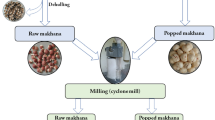Abstract
This work was undertaken to evaluate the effect of soaking, sprouting, cooking and fermentation or their combinations on the nutrient and antinutrient contents of pearl millet seeds. Standard assay procedures were adopted to determine both the nutrient and the antinutrient concentrations of the products. The synergistic effect of cooking and fermentation improved the nutrient quality. The antinutrients were reduced to safe levels to a greater extent than did any of the other processing techniques or their combinations employed.
Similar content being viewed by others
References
Agboola SA (1979) An agricultural atlas of Nigeria. Oxford Univ Press, Ibadan, Nigeria.
Olatunji O, Akinrele IA, Edwards CO, Koleoso OA (1982) Sorghum and millet processing and uses in Nigeria. Cereal Fd Wld 27: 277.
Vermeer DE (1970) Population pressure and crop rotational changes among Tiv of Nigeria. Annals of Ass. Am. Geographers 60.
Rao DS, Deosthale YG (1983) Mineral composition, ionizable iron and soluble zinc in malted grains of pearl millet and rag. Food Chem 11: 217–223.
Chen LH, Wells CC, Fordham JR (1975) Germinated seeds for human consumption. J Food Sci 40: 1290–93.
Fordham JR, Wells CC, Chen LH (1975) Sprouting of seeds and nutrient composition of seeds and sprouts. J Food Sci 40: 552.
Wang YD, Fields ML (1976) Germination of corn and sorghum in the home to improve nutritive value. J Food Sci 43: 113–115.
Hamad AM, Fields ML (1979) Evaluation of the protein quality and available lysine of germinated and fermented cereals. J Food Sci 4: 456–59.
Heerden IV, Glennie CW (1987) Availability of B-vitamins in sorghum beer. Nutr Rept Int 35: 1–3.
Kazamas N, Fields ML (1981) Nutritional improvement of sorghum by fermentation. J Food Sci 46: 819–21.
Walker AF, Kokchar N (1982) Effect of processing including domestic cooking on nutritional quality of legumes. Proc Nutr 41: 41.
Panasuik O, Bills DD (1984) Cyanide contents of sorghum sprouts. J Food Sci 49: 791–793.
AOAC (1980) Official Methods of Analysis, 13th ed. Washington DC: Assoc Official Analytical Chemists.
Price ML, Hagerman AE, Butter LG (1980) Tannin content of cowpea, pigeon and mung beans. J Agric Food Chem 28: 459.
Steel RGD, Torrie JH (1960) Principles and procedures of stastistics with special reference to the biological sciences. McGraw-Hill, New York, London and Toronto.
Raham EH, Aal MH (1986) Changes in gross chemical composition with emphasis on lipid and protein fractions during germination of Fenugreek seeds. Food Chem 22: 193.
Farhangi M, Valadon LRG (1981) Effects of acidified processing and storage on carotenoids (Provitamin A) and vitamin C in mungbean sprouts. J Food Sci 46: 1464.
Chavan JK, Kagam SS, Salunke DK (1981) Changes in tannin, free fatty acids, reducing sugar and starch during seed germination of low and high tannin cultivars of sorghum. J Food Sci 46: 638.
Ologhobo AD, Fetuc BL (1986) Changes in carbohydrate content of germinating cowpeas seeds. Food Chem 20: 117.
Jaya YV, Venkataraman LV (1981) Changes in the carbohydrate constituent of chick pea and green gram during germination Food Chem 7: 95.
Oke OL (1969) The role of hydrocyanic acid in nutrition. Wld Rev Nutr Diet 11: 118.
Oke OL (1979) Some aspects of the role of cyanogenic glucosides in nutrition. Wld Rev Nutr Diet 33: 70.
Osuntokun VO (1981) Casava diet chronic cynide intoxification and neuropathy in Nigerian Africans. Wld Rev Nutr Diet.
Klopfenstein CF, Hoseney RC, Liepold HW (1983) Goitrogenic effects of pearl millet diets. Nutr Rept Int 27: 1039.
Au PM, Fields ML (1981) Nutritive quality of fermented sorghum J Food Sci 46: 652.
Author information
Authors and Affiliations
Rights and permissions
About this article
Cite this article
Obizoba, I.C., Atii, J.V. Evaluation of the effect of processing techniques on the nutrient and antinutrient contents of pearl millet (Pennisetum glaucum) seeds. Plant Food Hum Nutr 45, 23–34 (1994). https://doi.org/10.1007/BF01091226
Received:
Accepted:
Issue Date:
DOI: https://doi.org/10.1007/BF01091226




